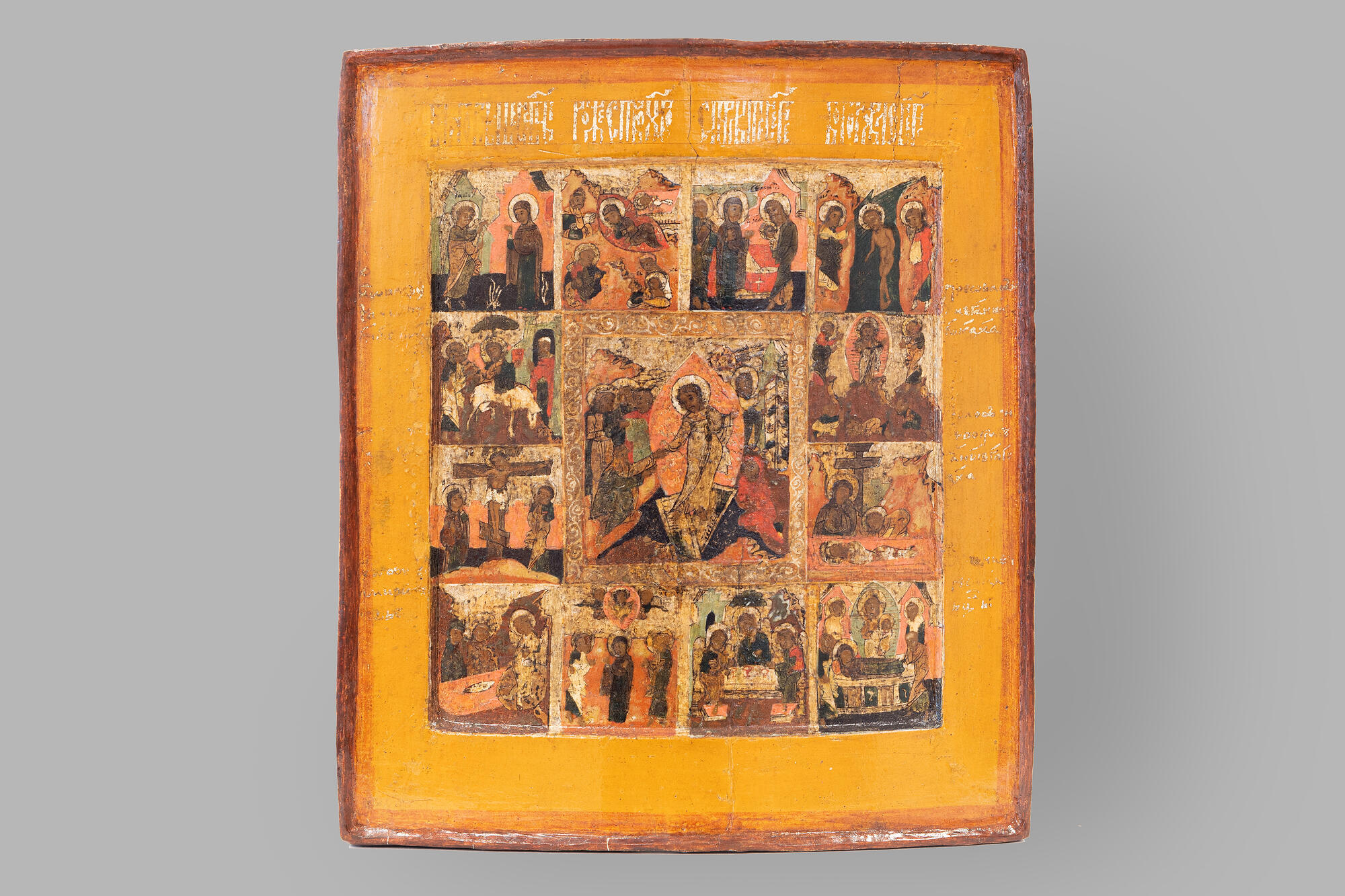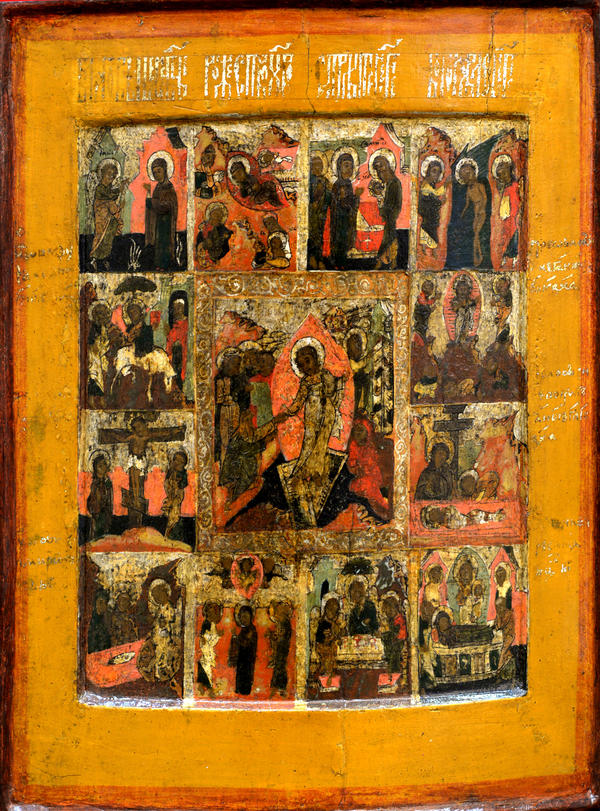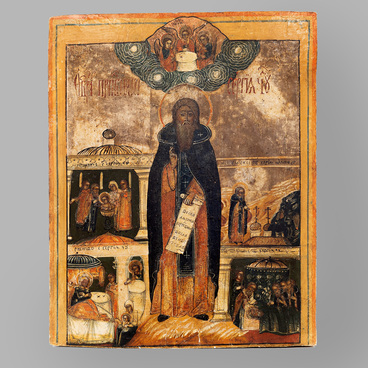The icon “The Resurrection of Christ with Feasts” is one of the icons of Saint Nicholas Church in the village of Kovda.
In the center of the icon “The Resurrection of Christ with Feasts” is Christ trampling the broken gates of Hell. Around the centerpiece are 12 scenes, which are canonical images of 12 church feasts.
Epiphany: one of the oldest holidays of the Christian calendar is the Baptism of Jesus Christ in the Jordan, which laid the foundation for the Church Sacrament of Baptism.
Entrance to Jerusalem: Christ, sitting on a young donkey, accompanied by his disciples, on the eve of the Jewish Passover, enters the city where He will be betrayed to be crucified.
Transfiguration: the iconography of the holiday was based on the gospel narrative. The Savior standing on the mountain is depicted in the center of the composition, on the sides of him are the prophets, at the foot of the mountain are the prostrate apostles. Half of the space is occupied by rocks — they symbolize strong faith and the ascent that a believer must make on the way to Eternity.
Crucifixion: the scene of the execution of Christ. Jesus, seeing His Mother and John, says to His Mother: “Woman, behold your son.” Then he says to John: “Behold your mother.” From that time on, John took the Mother of God to his house and took care of Her until the end of Her life.
Entombment: the burial of the body of Jesus Christ described in the Gospels, which took place on the evening of Good Friday.
Myrrh-bearing women: women who came in the morning on the first day after Saturday to the Tomb of the risen Jesus Christ, with incense for the ritual anointing of the body of the deceased.
Ascension: the ascension of Jesus Christ in the flesh into heaven, the promise of His second coming. In the Christian tradition, the holiday is celebrated on the 40th day after Easter and always on a Thursday.
The Old Testament Trinity: in the iconography of the Trinity, the plot of the so-called hospitality of Abraham is most often used — the appearance of three angels to him. In Christian theology, three angels symbolize the hypostases of God, which are thought of as the consubstantial Holy Trinity.
Assumption of the Mother of God: Virgin Mary on her deathbed. At Her head and at Her feet are the apostles, miraculously transferred to Jerusalem at Her prayer to say farewell before her death and take part in the burial ceremony. In the center above the bed is Jesus Christ, taking into His arms the purest soul of His Mother in the form of a newborn baby in white swaddling clothes, a symbol of the fact that in Orthodoxy any person’s death is conceived as a birth into eternal life.
In the center of the icon “The Resurrection of Christ with Feasts” is Christ trampling the broken gates of Hell. Around the centerpiece are 12 scenes, which are canonical images of 12 church feasts.
Epiphany: one of the oldest holidays of the Christian calendar is the Baptism of Jesus Christ in the Jordan, which laid the foundation for the Church Sacrament of Baptism.
Entrance to Jerusalem: Christ, sitting on a young donkey, accompanied by his disciples, on the eve of the Jewish Passover, enters the city where He will be betrayed to be crucified.
Transfiguration: the iconography of the holiday was based on the gospel narrative. The Savior standing on the mountain is depicted in the center of the composition, on the sides of him are the prophets, at the foot of the mountain are the prostrate apostles. Half of the space is occupied by rocks — they symbolize strong faith and the ascent that a believer must make on the way to Eternity.
Crucifixion: the scene of the execution of Christ. Jesus, seeing His Mother and John, says to His Mother: “Woman, behold your son.” Then he says to John: “Behold your mother.” From that time on, John took the Mother of God to his house and took care of Her until the end of Her life.
Entombment: the burial of the body of Jesus Christ described in the Gospels, which took place on the evening of Good Friday.
Myrrh-bearing women: women who came in the morning on the first day after Saturday to the Tomb of the risen Jesus Christ, with incense for the ritual anointing of the body of the deceased.
Ascension: the ascension of Jesus Christ in the flesh into heaven, the promise of His second coming. In the Christian tradition, the holiday is celebrated on the 40th day after Easter and always on a Thursday.
The Old Testament Trinity: in the iconography of the Trinity, the plot of the so-called hospitality of Abraham is most often used — the appearance of three angels to him. In Christian theology, three angels symbolize the hypostases of God, which are thought of as the consubstantial Holy Trinity.
Assumption of the Mother of God: Virgin Mary on her deathbed. At Her head and at Her feet are the apostles, miraculously transferred to Jerusalem at Her prayer to say farewell before her death and take part in the burial ceremony. In the center above the bed is Jesus Christ, taking into His arms the purest soul of His Mother in the form of a newborn baby in white swaddling clothes, a symbol of the fact that in Orthodoxy any person’s death is conceived as a birth into eternal life.



